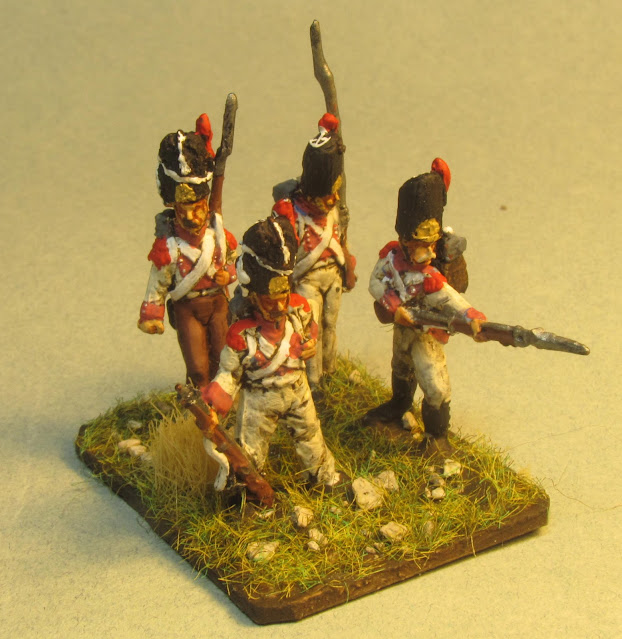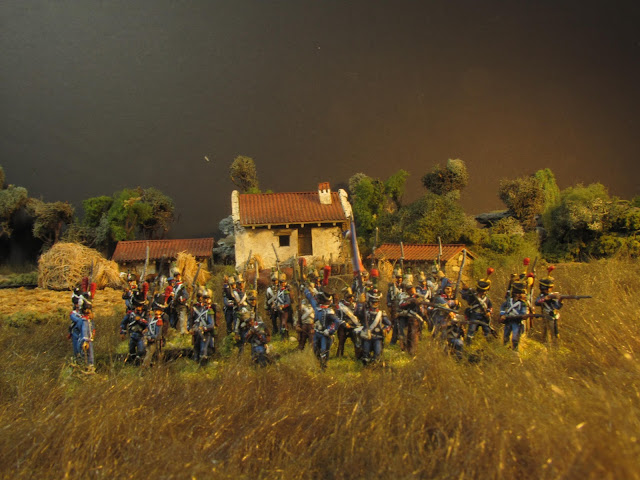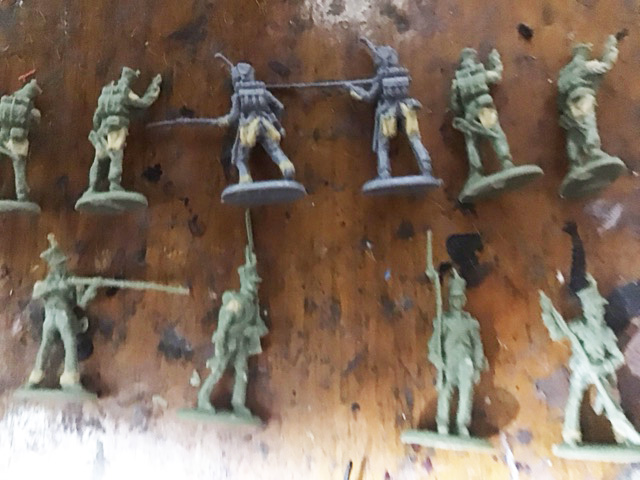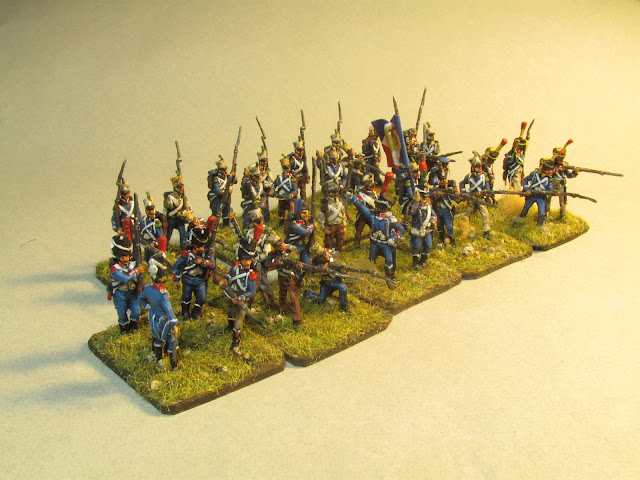
Continuing with my build of Leval's 2nd German Division that fought at Talavera, I decided to move on to the Dutch (Kingdom of Holland) troops. I had already completed the Baden and Nassau infantry (the latter done back in 2019 and augmented with a couple of new stands to bring up their numbers) who were brigaded together in the first of my 2nd German Division brigades. The Dutch comprised their own brigade, being made up (confusingly) of the 1st Battalion of the 2nd Regiment and the 2nd Battalion of the 4th Regiment. They were supported by a battery of Dutch horse artillery.
These were a fun but challenging build. My reference indicated that they wore a uniform quite similar to the later French line infantry uniform, with closed lapels, only a bit of waistcoat showing and standard French kit. I have seen some reference afterwards that may indicate otherwise, but it also appeared to me that they had short tails on their coats. The only major difference is that the shako plumes are on the side rather than the front.
There is an Italeri set (6066) that would have served admirably, with only a change up on the plumes, but in dogged fashion I continue to try and utilize what I already have in the cupboard and that set isn't to be found there! I did, however, have access to the late French infantry set by Esci (227), a strange set that gets quite a few things wrong (you can read all about it on Plastic Soldier review) but looked as if they could be adapted. I have a few of my crappy WIP photos that I will share, but essentially I closed off the lapels, covering up the waistcoat and gave them new plumes on the side of their shakos. Some of these figures have the double frog for sabre briquet and bayonet (although oddly no fringed epaulettes!) so I added fringed epaulettes to those and used them as voltigeurs. The biggest hurdle was that all of these figures have the crossed straps, although a number of the figures do not have the bayonet and sabre-briquet the second strap would have carried! This strap is quite thin, however, so I changed it to a strap for water canteens which I sculpted onto the fusiliers. They all had cuff flaps that needed to be cut off.
Finally, I changed almost all of the figures from knee high gaiters to wearing campaign trousers, a look that I much prefer.
 |
| A not great WIP photo. A few of the figures received forage caps and all had the plume cut off and a new one placed at the side of the shakos. I closed off the waistcoat with putty, gave them campaign trousers and if you look closely, you can see the rear view figures all have had canteens added to justify the second cross strap - a mix of metal canteens and gourds, some in wicker cases, reflecting the anything goes approach of the French and their allies in Spain. |
I also used a few Poles from various Strelets sets to flesh out the numbers as the Polish uniform was a good match as well. These were mostly used as grenadiers as they had the proper bearskin (although, again, a plume was required on the side), with a few ending up on the two command stands along with some figures from the French Light Infantry Command set by HaT.
These figures represent the conversions for two battalions, with the 2/4th to follow in my next post.
 |
| The voltigeurs. These were made up from Strelets Poles (red and blue figures that received French heads) and the Esci figures that had been molded with the sabre-briquet. Again, new side plumes, trousers and epaulettes have been added. |
 |
| Strelets Poles serve as the Dutch grenadiers, with some head swaps, plume additions and a bit of gear added. |
 |
| The command stand was made up of a mounted HaT light infantry commander and two Strelets Polish figures. The drummer received a head swap, the grenadier a new flagstaff. |

A Bit of History
The Kingdom of Holland was created by Napoleon in 1804, with Napoleon overthrowing the Batavian Republic and placing his brother Louis Bonaparte on the throne. However Louis held Dutch interests above Napoleon's own, leading to the dissolution of the Kingdom of Holland in 1810, at which point the Netherlands were annexed by France until 1813.
Like all of France's puppet states, the Kingdom of Holland was expected to contribute forces to Napoleon's campaigns. In August of 1808 a composite regiment formed of the 1st Battalion of the 2nd Regiment and the 2nd Battalion of the 4th Regiment, supported by a battery of Dutch horse artillery were sent to Spain, becoming part of Laval's 2nd German Division. They only met the British at Talavera and later Vittoria, being thrown into the grinding war in Catalonia and nearly wiped out during the seige of Girona. Most of their time in Spain was spent in small contingents doing outpost duty battling the Spaniards.
I saved myself a whole lot of time by simply referencing Jonathan Jones' excellent work done on this division through his blog, which can be found here:
http://jjwargames.blogspot.com/2014/10/napoleons-german-division-at-talavera.html
For more detailed information on their uniforms see:
https://www.napoleon-series.org/military-info/organization/GermansinSpain/GermanSpainChapter1b.pdf
https://www.napoleon-series.org/military-info/organization/Dutch/c_Suhrholland.html
Here are the results for the Dutch 1/2nd Infantry Regiment - as I said, a lot of work but fun to do. I hope you enjoy them!
 |
| A few of the figures received heads with forage caps. The cuff straps have been removed and two silver buttons painted on. |
 |
| Here you can see the addition of the canteens to justify the second crossbelt on the Esci figures. |





































